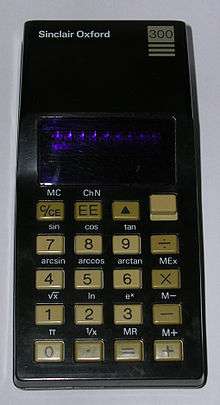Sinclair Oxford
Sinclair Oxford was a range of low-cost scientific calculators manufactured and sold by Sinclair Radionics in England from 1975 until 1976.
 Sinclair Oxford 300 calculator | |
| Type | Scientific calculator |
|---|---|
| Manufacturer | Sinclair Radionics |
| Introduced | Spring 1975 |
| Discontinued | Date of discontinuation |
| Calculator | |
| Display type | Light-emitting diode/ Vacuum fluorescent display (Type 1s used the LED and Type 2s the VFD)[1] |
| Display size | 8 digits |
| Programming | |
| Other | |
| Power supply | PP3 battery |
| Weight | 138 grams (Oxford 300 excluding batteries)[2] |
| Dimensions | 73 by 155 by 34 millimetres (2.9 in × 6.1 in × 1.3 in) |
History
In November 1974, Gillette wanted to enter the consumer electronics market, so consulted Sinclair, who designed for them the Gillette GPA.[3] Whilst the GPA was released, Gillette put the product on hold after a short time due to economic and pricing uncertainties.[3] Sinclair would use the GPA design for the Oxford range, the development and tooling of which had been paid for by Gillette.[3]
The first model was the Oxford 100, launched in Spring 1975 for GB£12.95 (all prices exclude VAT); and essentially the same as the GPA.[3][4] Both the Gillette GPA and Oxford 100 models used 8 digit displays with red light-emitting diodes (LEDs), 4 functions, 9 volt PP3 batteries, and measured 73 by 155 by 34 millimetres (2.9 in × 6.1 in × 1.3 in).[4]
Models
All the Oxford models were similar in appearance; the 150 was introduced in 1975 introducing the ability to calculate percentages and square roots.[3][5] The Oxford 200 included memory and sold for £19.95.[3] The Oxford 300 was a scientific model with a limited number of functions (such as sin, cos, tan), which sold for £29.95, much lower than the competition.[3][6] The last two models, the Oxford Scientific (1976) and Oxford Universal were the most advanced of the range.[3]
The high power consumption of the calculators, which drew 40 mA while in operation, four times the recommended limit of the batteries, meant a short battery life. Computer Digest recommended using a much larger PP9 battery, but that meant losing the portability of the calculator.[3]
References
- "Oxford". Vintage Sinclair. Retrieved 8 December 2013.
- "Sinclair Oxford 300 (Type II)". vintage-technology.info. Retrieved 8 December 2013.
- "Sinclair Oxford 1975-76". Planet Sinclair. Retrieved 8 December 2013.
- "Gillette GPA / Sinclair Oxford 100". vintagecalculators.com. Retrieved 8 December 2013.
- "Sinclair Oxford 150". vintagecalculators.com. Retrieved 8 December 2013.
- "Sinclair Oxford Scientific Calculator". tvfilmprops.co.uk. Retrieved 8 December 2013.